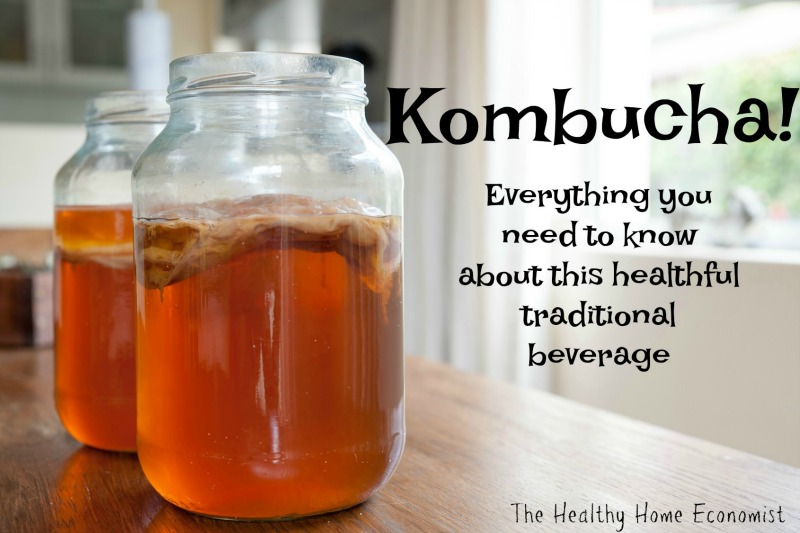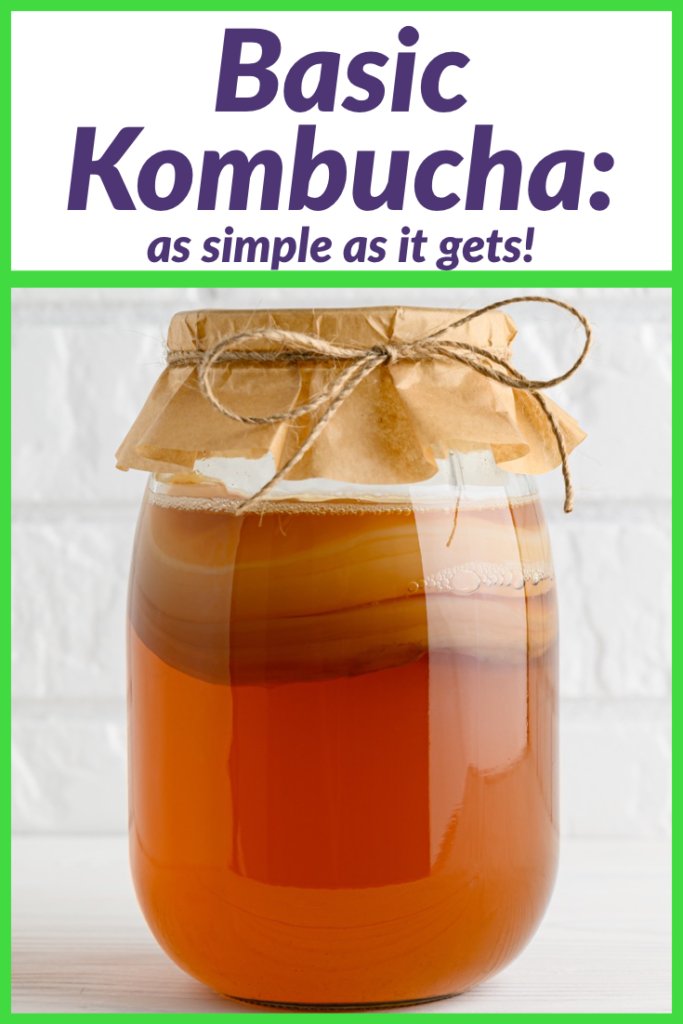Table of Contents[Hide][Show]
Easiest method to make kombucha at home in order to enjoy this delicious, traditional beverage without resorting to commercial versions that can be improperly fermented or high in sugar and fluoride.

Kombucha is arguably one of the hottest beverage trends to sweep the world in recent years. The discussion, recipe, and video demonstrations below provide all the information you need to understand kombucha benefits to health and how to make this tasty probiotic beverage in your home.
The traditional probiotic drink made from fermented tea originated in China and then Russia. It is made with black, green, or white tea and cane sugar. Kombucha has a colorful history. Ancestral cultures enjoyed it for many centuries before it was “rediscovered” in the 1990s in the United States. In China, kombucha resembled Jun tea, using green tea and honey. In Russia, fermented tea used black tea and cane sugar.
Extensive testing in Russia many decades ago proved it to be an effective overall body detoxifier. This occurs through the binding of the organic acids in the beverage to all manner of toxins present in the body. Once tightly bound to the organic acids, the toxins are rushed to the kidneys for excretion.
Russian communities that drink a lot of fermented tea do not suffer from the cancer epidemics that plague folks who live near that country’s toxin spewing factories — even when the local flora and fauna are dying!
The Soviet Union before the fall of the Iron Curtain used kombucha as one of its secret weapons in the development of its Olympic athletes. While training, athletes would drink up to 1 quart of kombucha per day to prevent lactic acid from accumulating in the muscles (lactic acid = sore muscles). Those drinking this brew were able to train harder and longer than athletes who did not drink kombucha.
The best thing about kombucha is that is bubbly, delicious, and extremely hydrating. It very adequately replaces all the sports drinks and sodas that everyone seems addicted to today. My family has been drinking kombucha for over 15 years now. Its longstanding reputation for preventing gray hair is astonishing.
What is a SCOBY?
Sometimes you will hear a kombucha culture referred to as a SCOBY. This acronym means Symbiotic Culture Of Bacteria and Yeasts. Because a SCOBY is loaded with beneficial microbes, it makes some of the best garden compost. It is also beloved by insects and other critters. So, if you happen to get a SCOBY fruit fly infestation, refer to the referenced article for how to recover without damaging your culture.
Some people are surprised that kombucha contains yeasts as well as probiotic bacteria. These yeasts are beneficial, however, and fight off pathogenic strains in the GI tract like Candida albicans.
How to Start Drinking Fermented Beverages
Kombucha is a wonderful addition to a healthy diet. One word of warning is to go slow when you first start drinking it. This advice is the same for any other fermented beverage like water kefir or beet kvass. The probiotic infusion can sometimes cause loose stools or other mild symptoms for a day or two.
Start with just a couple of ounces a day. Over the span of about a week, build up to a maximum of 8-12 oz daily. This drink is very cleansing and helpful to the body, but overdoing it at the beginning can give you a bit of a headache or other detox symptoms, so go easy!
Kombucha During Pregnancy and Breastfeeding
I started drinking kombucha for the first time when 6 months pregnant with my second child. I started very slow, drinking only a couple ounces per day.
After a few weeks, I consumed a maximum of 12 oz per day for the remainder of the pregnancy. Drinking kombucha during breastfeeding presented no problems. The beverage seemed to help me stay hydrated which indirectly boosted my milk supply.
The kombucha I consumed was always carefully homemade. I chose not to drink store-bought kombucha as the quality of the tea leaves is unknown. Using old tea leaves that are steeped too long can lead to excessive fluoride in kombucha.
In addition, brewing an acidic drink in stainless steel vats, which is the typical commercial method, can leech carcinogenic nickel as well. Flavored varieties contain an unacceptable level of sugar too. Note that high sugar store-bought kombucha is a candida risk.
Kombucha Tea for Children
I started giving a couple of ounces of kombucha to my children when they were about 18 months old. Take care never to put kombucha in a plastic or stainless steel sippy cup. Acidic kombucha will leech toxins from anything but clear glass. Hold a glass yourself and let them sip it or use a glass sippy cup with a safety sleeve.
My children are now 18, 15, and 12, and I am so grateful they are healthy. They’ve never required any antibiotics for illness which I attribute partly to their regular consumption of fermented foods and drinks like kombucha.
Traveling with Fermented Tea
Transporting and packing kombucha in a lunchbox takes a bit of thought. It must ideally be packed in clear glass and protected from shattering with a foam sleeve should the bottle be dropped.
Packing it in stainless steel or plastic bottles risks leeching chemicals and/or heavy metals like nickel into the beverage.
Even “food grade” plastic bottles that claim to be BPA free and non-leeching must be avoided when transporting kombucha.
Kombucha Myths
A number of kombucha myths persist despite attempts to debunk them from the traditional foods community.
One is that the SCOBY is a mushroom. For a discussion of the 7 common kombucha myths, refer to the linked article.
Modern Uses
Several ingenious ways to use fermented tea have appeared in recent years. For example, fashion designers are using SCOBY cellulose to make kombucha clothing. The process is essentially the microbial version of silkworms spinning silk.
In the future, kombucha may help colonize Mars. The sturdy cellulose is perfect as a renewable material for 3-D printing and other manufacturing purposes in space.
How to Make Kombucha
The two videos plus recipe below detail how to safely make a single batch of kombucha tea. If the continuous brew kombucha method interests you, click over to the linked article.
For those of you experienced with kombucha brewing already, I offer another set of videos that cover advanced kombucha topics. The videos demonstrate how to make large batches of fermented tea and other advanced techniques.
My hope is that these videos will show you how easy it is to make healthy, probiotic, delicious fermented tea in your home. Fermented beverages are critical to successfully kicking the soda habit once and for all. Anecdotally, several recovering alcoholics in my community found kombucha helpful to their journey as well.
Years ago, I used to teach Traditional Cooking classes in my home and at local health food stores. I was always sad to limit the number of people due to space restrictions. It is exciting to be able to post this type of information so as many people who want to see it can view it and benefit from it!

Traditional Homemade Kombucha Recipe
Basic traditional recipe for homemade kombucha using black and green tea and cane sugar as used for centuries.
Ingredients
- 3 quarts filtered water
- 1 cup white cane sugar preferably organic
- 2 black tea bags or 2 tsp loose tea
- 2 green tea bags or 2 tsp loose tea
- 1 gallon glass bowl
- 1 floursack cloth
- 1 large rubber band
- 1 kombucha culture
- 6 ounces kombucha starter
Instructions
-
Boil 3 quarts of water.
-
Add 1 cup white sugar to the boiling water and dissolve.
-
Continue to boil sugar water for 5 minutes.
-
Remove pot from heat and add 3 black tea bags and 2 green tea bags. Brew for 10 minutes.
-
Remove tea bags and let tea/sugar mixture cool to room temperature. Do not cool too long!
-
When the mixture is just room temperature (about 2 hours), add 6 oz of kombucha starter and 1 kombucha culture.
-
Cover with a white, pre-laundered floursack cloth and attach with a large rubber band.
-
Leave in a quiet semi-lit room (no direct sunlight) for 7-10 days. When a new “baby” culture forms on the top of the brew and it is at least 1/8 ” thick, you may harvest the brew.
-
Store in clear glass only in the refrigerator.
-
Repeat the process to brew as much as your family desires.
Recipe Video
Recipe Notes
It is important to only use cane sugar for this recipe. If you use plain white sugar from the supermarket, be sure it says 100% cane sugar. In North America, plain white sugar not labeled as cane sugar is all or partially beet sugar made from GMO beets.
In a pinch, you can use 4 ounces raw and unfiltered apple cider vinegar in place of the 6 ounces of kombucha starter.
Where to Buy Fermented Tea Cultures Plus Starter Liquid
Please do not buy your SCOBY culture from Laurel Farms as suggested in the video. This company is having serious delivery problems. Please go to my Resources page to find vetted sources that will ship you a culture promptly.
Alternatively, you can find someone in your community to give you a SCOBY plus starter liquid. In a pinch, you may use 4 ounces of store-bought (raw – glass bottles only) or homemade raw and unfiltered apple cider vinegar as the starter.









Hi Sara, I accidentally got Choice Organic Black Tea “ENGLISH Breakfast” (ingredients: organic black tea); instead of, Choice Organic Black Tea “CLASSIC Black” (ingredients: organic orange pekoe black tea). Would you suggest I wait to make my Kombucha tea batch until I get the CLASSIC BLACK? I also use their green tea as called for in your receipe. Thanks for your response in advance. 🙂
What you purchased will work fine!
Does my “resting” scoby have to be completely covered in liquid and is it best to store in fridge?
In my experience, yes, it is best to be completely submerged in liquid and covered with a white floursack cloth or dishtowel and secured with a rubber band. That’s how I’ve done it for almost 20 years and have never lost a SCOBY while on vacation or taking a break from brewing.
Hi Sara, I just got my 2 Kombucha cultures (the mushroom looking thing) from Kombucha Camp, Beverly Hills, CA. Wowed…Beverly Hills :). I put them directly into a glass bowl and covered with a washed tea towel (never seen bleach)… rubber banded it to bowl and put in my garage frig. I then red the PLASTIC bag it came in and it said not to refrigerate, but I’m hoping you will concur that that is not if you are going to leave it in the plastic bags they came in, in the komucha liquid (1 cup was in each bag). They are both in one glass bowl with all the liquid (starter) with the tea towel covering them and safe inn the frig. Am I on thee right track or should they have been shipped in clear glass containers? The plastic seemed pretty sturdy. They were double plastic bagged and shipped in box. Thank you so much for your time! I appreciate it very much. 🙂
It’s ok if they are briefly in plastic for shipping to your home. Kombucha Kamp says not to refrigerate, but I always do to prevent mold when I’m not using it. Florida where I live is quite humid and the risk of mold is much higher here. Do as you like … I’ve been brewing kombucha for almost 20 years and have always refrigerated my cultures in tea water when not actively brewing.
I have made 2 batches of kombucha. The first batch produced a second SCOBY, the second batch just increased it size significantly. I let each batch ferment for about 2 weeks. I feel that the resulting drink is a bit sweeter than I expected. Also, I have tried the trick where you bottle the kombucha, let it sit out for a couple of days to increase the carbonation. The carbonation does not appear to increase. Releasing the cap does not result in any gas coming out of solution! Any ideas of what I might be doing wrong?
I do use filtered water, an organic ‘kombucha’ tea, and an organic sugar.
If a new SCOBY was not produced, the batch did not “take”. The new SCOBY should be at least 1/8″ thick for the fermentation to be considered effective. Perhaps the SCOBY cultures you got were not viable.
I was really glad to read this article. (thank you!) Even though I have been making kombucha, you’ve shown a better way, and I am going to try that especially using a large bowl for the ferment. My question is about my scoby. I’ve made 3 batches of kombucha with it, but it has NEVER grown a baby. I thought maybe it’s because it’s been so cold this winter, and we keep the furnace between 62-68 to conserve propane. I have checked the scoby carefully each time, and there is no mold, but it also doesn’t change – doesn’t get thicker and never has started a ‘baby’. Do you think I should just get a new scoby or does this one sound like it’s still safe? I have drank most of the kombucha tea (one I let ferment too long and it was not good tasting, so it had to be thrown out) and I’ve never experienced any bad effects and the tea was delicious. Thank you! ~~ Vee
Thanks for this informative post and video! My SCOBY in en route as we speak! I see that you use a glass bowl whereas other tutorials I see use a glass pickle jar or mason jar. What are the reasons you use the bowl? I was just considering the footprint it’ll take up on the counter or in another room for that extended time, or how safe I feel carrying it to another room with that much surface area on top. Does it breathe better with more surface area? Obvious the SCOBY will be bigger. Is there a reason I shouldn’t do a pickle jar or Mason jar if that’s what I have on hand? Thanks for your wealth of knowledge and willingness to share it and teach others! I appreciate it.
The surface area is very important when brewing kombucha. This is why you shouldn’t make it in a jar where the lid area is significantly more narrow than the depth. The chances of the fermentation fail are much greater when using those types of jars. Let us know how it turns out!
Thank you so much for the quick reply!
I think I only have enough starter for one batch, meaning my other culture will be left without any kombucha to stay in between brews. Do you recommend I throw out the other, or do you think it’s possible to double the batch and use both even though I don’t have much starter?
If the culture isn’t in tea water, it will die in short order. Doubling the batch and using both won’t work if you only have enough starter for one batch.
Hi, thank you so much for these videos and information. I have a few questions.
I was given a few cultures and starter. Do I only put one of the cultures in each brew?
Also, when cleaning the flour sacks, should I avoid dryer sheets or any sort of scented detergent?
I was told to keep my culture unrefrigerated. Should it be in the fridge?
How do I know if the culture has gone bad?
Thanks!
Yes, use one culture per bowl of brew. Good practice to avoid any synthetics when washing and drying your flour sack clothes too. I never use dryer sheets or fabric softener and use unscented laundry powder too.
If the culture gets mold on it, then it must be tossed. You can store on the counter in tea water if it will be just a few days between brew cycles. If it is longer than that, I would recommend storing in the fridge in plenty of tea water covered with a secured flour sack cloth.
Thank you so much for linking to the common myths about Kombucha! I’ve heard those all before and to know they are myths is relieving. Thank you for your informative post!
Hi Sarah. I’m curious about kombucha for pets (my 15 lb dog specifically) and babies. Do you have any information on that? Thanks!